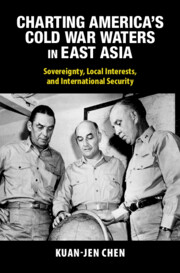 Charting America's Cold War Waters in East Asia
Charting America's Cold War Waters in East Asia Book contents
- Charting America’s Cold War Waters in East Asia
- Cambridge Studies in US Foreign Relations
- Charting America’s Cold War Waters in East Asia
- Copyright page
- Contents
- Figures, Tables, and Maps
- Abbreviations
- Conventions
- Acknowledgements
- Introduction
- 1 Finding a Local Partner in Post-war Maritime East Asia
- 2 The Creation of a Mainland-Based Forward Strategy
- 3 Vying for Top Dog: The Navy–Army Struggle in Maritime East Asia
- 4 Termination of the Mainland-Based Forward Strategy
- 5 The 1950 Crises and America’s Changing Posture of Defence
- 6 The Making of a New Maritime Strategy
- 7 The International Law of the Sea and America’s Unreliable Partners
- 8 America’s Strange Bedfellows in the International Arena
- 9 Fishing for Protein in Cold War East Asia
- 10 Jostling for Position: Black Gold, Natural Resource Exploration, and Shifting Political Contours
- Epilogue
- Bibliography
- Index
9 - Fishing for Protein in Cold War East Asia
Published online by Cambridge University Press: 23 May 2024
- Charting America’s Cold War Waters in East Asia
- Cambridge Studies in US Foreign Relations
- Charting America’s Cold War Waters in East Asia
- Copyright page
- Contents
- Figures, Tables, and Maps
- Abbreviations
- Conventions
- Acknowledgements
- Introduction
- 1 Finding a Local Partner in Post-war Maritime East Asia
- 2 The Creation of a Mainland-Based Forward Strategy
- 3 Vying for Top Dog: The Navy–Army Struggle in Maritime East Asia
- 4 Termination of the Mainland-Based Forward Strategy
- 5 The 1950 Crises and America’s Changing Posture of Defence
- 6 The Making of a New Maritime Strategy
- 7 The International Law of the Sea and America’s Unreliable Partners
- 8 America’s Strange Bedfellows in the International Arena
- 9 Fishing for Protein in Cold War East Asia
- 10 Jostling for Position: Black Gold, Natural Resource Exploration, and Shifting Political Contours
- Epilogue
- Bibliography
- Index
Summary
The author argues that relations within East Asia also shaped US foreign policy in maritime East Asia by taking fishing resources into account. The author details that the United States made expedient use of fishing resources in the western Pacific to consolidate Japan’s internal order immediately after the war lest it became yet another divided country, which would undermine America’s international security order in East Asia. Accordingly, the United States unilaterally took command of some of the bountiful fishery resources to help Japan along towards its post-war economic revival. The end of the occupation of Japan marked a watershed in America’s natural resource policy for the western Pacific. After 1952, the United States gradually took a backseat in natural resource management. When Japan turned to China to negotiate over fishing rights, it was a sign that the Cold War on the seas was not absolutely black and white. This also provides a way of understanding America’s multiplicity and flexibility in its East Asian policy.
Keywords
- Type
- Chapter
- Information
- Charting America's Cold War Waters in East AsiaSovereignty, Local Interests, and International Security, pp. 242 - 264Publisher: Cambridge University PressPrint publication year: 2024
